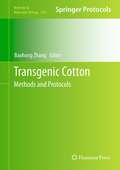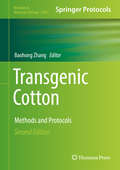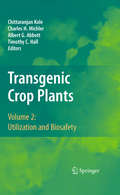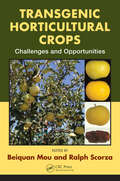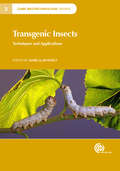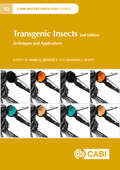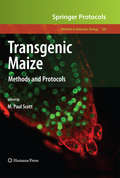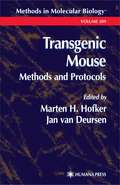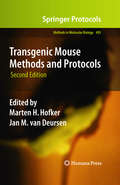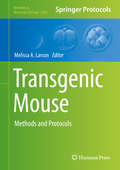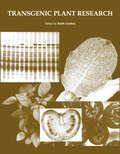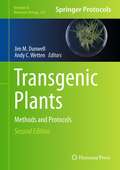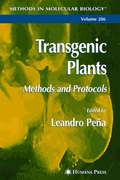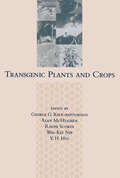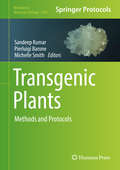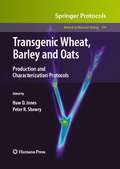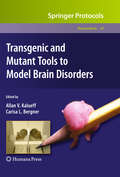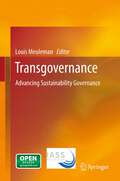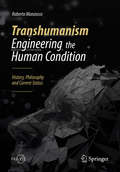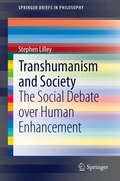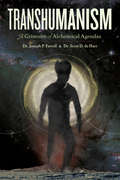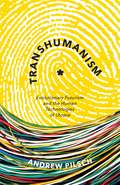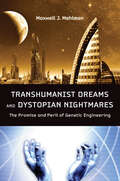- Table View
- List View
Transgenic Cotton
by Baohong ZhangCotton is the most important textile and cash crop and is widely cultivated in more than 70 countries, including the United States, China, and India. Because its long life cycle and complicated genetic background, it is hard to improve cotton using traditional breeding techniques although it has made much progress in the last several decades. Currently, transgenic techniques have become a powerful tool to improve cotton and transgenic cotton is among the first commercially genetically modified crops. Transgenic Cotton: Methods and Protocols provides a comprehensive collection of methods for creating and monitoring transgenic cotton and its application on agricultural and basic research. Divided into five convenient sections, topics covered include the current status and perspectives of transgenic cotton, the principle and methods for making transgenic cotton, the methods for detecting foreign gene copy and expression in transgenic plants, the improvement of cotton using transgenic technology, and finally the methods for monitoring the potential impact of transgenic cotton on environment, including gene flow. Written in the successful Methods in Molecular BiologyTM series format, chapters include introductions to their respective topics, lists of the necessary materials and reagents, step-by-step, readily reproducible protocols, and notes on troubleshooting and avoiding known pitfalls. Authoritative and easily accessible, Transgenic Cotton: Methods and Protocols will serve as an excellent resource for scientists as well as graduate students who work on transgenic plants, plant genetics, molecular biology and agricultural sciences.
Transgenic Cotton: Methods And Protocols (Methods in Molecular Biology #958)
by Baohong ZhangThis second edition provides a comprehensive collection of the cutting-edge methods for creating and monitoring transgenic cotton and its application on agricultural and basic research. Chapters detail current status and perspectives of transgenic cotton, principle and methods for making transgenic cotton, creating gene knockout lines, foreign gene copy and expression in transgenic plants, improvements to cotton using transgenic technology, and monitoring the potential impact of transgenic cotton on environment. Written in the highly successful Methods in Molecular Biology series format, chapters include introductions to their respective topics, lists of the necessary materials and reagents, step-by-step, readily reproducible laboratory protocols, and tips on troubleshooting and avoiding known pitfallsAuthoritative and cutting-edge, Transgenic Cotton: Methods and Protocols 2nd aims to be a resource for scientists as well as graduate students who work on transgenic plants, plant genetics, molecular biology, and agricultural sciences.
Transgenic Crop Plants
by Charles Michler Albert G. Abbott Timothy C. Hall Chittaranjan KoleDevelopment of transgenic crop plants, their utilization for improved agriculture, health, ecology and environment and their socio-political impacts are currently important fields in education, research and industries and also of interest to policy makers, social activists and regulatory and funding agencies. This work prepared with a class-room approach on this multidisciplinary subject will fill an existing gap and meet the requirements of such a broad section of readers. Volume 2 with 13 chapters contributed by 41 eminent scientists from nine countries deliberates on the utilization of transgenic crops for resistance to herbicides, biotic stress and abiotic stress, manipulation of developmental traits, production of biofuel, biopharmaceuticals and algal bioproducts, amelioration of ecology and environment and fostering functional genomics as well as on regulations and steps for commercialization, patent and IPR issues, and compliance to concerns and compulsions of utilizing transgenic plants.
Transgenic Horticultural Crops: Challenges and Opportunities
by Ralph Scorza Beiquan MouAs the world debates the risks and benefits of plant biotechnology, the proportion of the global area of transgenic field crops has increased every year, and the safety and value continues to be demonstrated. Yet, despite the success of transgenic field crops, the commercialization of transgenic horticultural crops (vegetables, fruits, nuts, and or
Transgenic Insects
by Mark Quentin BenedictInsect transgenesis promises improvements in agriculture, pharmaceuticals and public health. Many important insects can now be routinely transformed with effectors that have useful applications. Agriculture presents the largest market for transgenic insects and has a foundational history of success with sterile insect technique for control of pests including Mediterranean fruit flies and screwworms. Biotechnology will contribute superior markers, suppressible sterility and sex-conversion. Public health is also seeing transgenic mosquitoes developed which suppress natural populations and are incapable of transmitting disease. Experts in the field will contribute their insights into the latest technology and its applications. Authors will also consider the larger risks, social and economic aspects of transgenic insects whose value must be proven in political, regulatory and public acceptance arenas.
Transgenic Insects: Techniques and Applications (CABI Biotechnology Series #3)
by Brian L. Weiss Arvind Sharma Andrew Hammond Nicole Klein John Mumford Ricardo Pereira Lucy Carter Claudia Emerson Guy Smagghe Ravi V. Durvasula Tony Nolan Serap Aksoy Aaron Roberts Hassan M. Ahmed Omar S. Akbar Yehonatan Alcalay Luke Alphey Yael Arien Rotem Daniel Avraham Camilla Beech Nicholas J. Bongio Vanessa Bottino-Rojas L. Roman Carrasco Jackson Champer Isabelle Coche Carolina Concha Rocco D’Amato Brinda Dass Jason A. Delborne Ellen M. Dotson Matthew P. Edgington Guido Favia Adam P. Forshaw Alexander W.E. Franz Marisa L. Guido Monika Gulia-Nuss Daniella An Haber Alfred M. Handler Keith R. Hayes Ivy Hurwitz Anthony A. James Thomas P. Kelly Ana Kormos Lee Benjamin Lamdan David J. Lampe Rosemary S. Lees Maria Vittoria Mancini Aditi Mankad Andrew Nuss David A. O’Brochta Riccardo Papa Philippos Aris Papathanos Michael Pham Megan Quinlan Robyn Raban Jason L. Rasgon Yasha Rohwer Nathan Rose Marc F. Schetelig Kristof De Schutter Hideki Sezutsu Gregory S. Simmons Toshiki Tamura Delphine Thizy Lea Pare Toe Ernst A. Wimmer Liu YangTechnology for modifying the genotypes and phenotypes of insects and other arthropods has steadily progressed with the development of more precise and powerful methods, most prominently transgenic modification. For many insect pests, there is now almost unlimited ability to modify phenotypes to benefit human health and agriculture. Precise DNA modifications and gene drive have the power to make wild-type populations less harmful in ways that could never have been performed with previous transgenic approaches. This transition from primarily laboratory science to greater application for field use has also necessitated greater development of modeling, ethical considerations and regulatory oversight. The 2nd Edition of Transgenic Insects contains chapters contributed by experts in the field that cover technologies and applications that are now possible. This edition includes increased attention to associated challenges of risk assessment, regulation, and public engagement. Featuring: Up-to-date analysis of molecular techniques, such as gene editing. Consideration of public attitudes and regulatory aspects associated with transgenic insects. Many examples of the wide range of applications of transgenic insects. This book will be very valuable to students and researchers in entomology, molecular biology, genetics, public health and agriculture, and will also appeal to practitioners who are implementing the technology, and to regulators, stakeholders and ethicists.
Transgenic Insects: Techniques and Applications (CABI Biotechnology Series #3)
by Mark Q. BenedictInsect transgenesis promises improvements in agriculture, pharmaceuticals and public health. Many important insects can now be routinely transformed with effectors that have useful applications. Agriculture presents the largest market for transgenic insects and has a foundational history of success with sterile insect technique for control of pests including Mediterranean fruit flies and screwworms. Biotechnology will contribute superior markers, suppressible sterility and sex-conversion. Public health is also seeing transgenic mosquitoes developed which suppress natural populations and are incapable of transmitting disease. Experts in the field will contribute their insights into the latest technology and its applications. Authors will also consider the larger risks, social and economic aspects of transgenic insects whose value must be proven in political, regulatory and public acceptance arenas.
Transgenic Maize
by M. Paul ScottAs increasing global population and continuing economic development ensure the need for further production and cultivation of maize, the necessity of the application of transgenic technology to this model species and crop plant grows steadily. In Transgenic Maize: Methods and Protocols, experts in the various disciplines of the field contribute readily reproducible protocols covering such topics as transformation methods, transgenic maize in research, the analysis of transgenic plants, and breeding with transgenes. Written in the highly successful Methods in Molecular BiologyTM series format, the chapters present brief introductions to their respective topics, lists of the necessary materials and reagents, step-by-step laboratory protocols, and notes on troubleshooting and avoiding known pitfalls. Cutting-edge and easy to use, Transgenic Maize: Methods and Protocols will greatly aid researchers wishing to use these procedures in their own laboratories, and will provide readers with a better understanding of the experiments being performed by cooperators or fee-for-service labs.
Transgenic Mouse Methods and Protocols
by Marten H. Hofker Jan Van DeursenMarten Hofker and Jan van Deursen have assembled a multidisciplinary collection of readily reproducible methods for working with mice, and particularlyfor generating mouse models that will enable us to better understand gene function. Described in step-by-step detail by highly experienced investigators, these proven techniques include new methods for conditional, induced knockout, and transgenic mice, as well as for working with mice in such important research areas as immunology, cancer, and atherosclerosis. Such alternative strategies as random mutagenesis and viral gene transduction for studying gene function in the mouse are also presented.
Transgenic Mouse Methods and Protocols, 2nd Edition
by Marten H. Hofker Jan Van DeursenMarten Hofker and Jan van Deursen have assembled a multidisciplinary collection of readily reproducible methods for working with mice, and particularlyfor generating mouse models that will enable us to better understand gene function. Described in step-by-step detail by highly experienced investigators, these proven techniques include new methods for conditional, induced knockout, and transgenic mice, as well as for working with mice in such important research areas as immunology, cancer, and atherosclerosis. Such alternative strategies as random mutagenesis and viral gene transduction for studying gene function in the mouse are also presented.<P><P> Fully updated from the first edition to offer cutting-edge methods for generation of transgenic mouse models
Transgenic Mouse: Methods and Protocols (Methods in Molecular Biology #2066)
by Melissa A. LarsonThis volume provides readers with a historical foundation in standard techniques and a comprehensive update on the latest methods used in making gene-modified mice. The chapters in this book cover topics such as pronuclear microinjection in one-cell embryos; embryo transfer surgery; nuclear transfer and cloning; blastocyst microinjection; and cryobanking and recovery of genetically modified mice. Importantly, there are chapters devoted to the latest application of CRISPR technology, as well as the establishment of induced pluripotent stem cells. Written in the highly successful Methods in Molecular Biology series format, chapters include introductions to their respective topics, lists of the necessary materials and reagents, step-by-step, readily reproducible laboratory protocols, and tips on troubleshooting and avoiding known pitfalls.Comprehensive and authoritative, Transgenic Mouse: Methods and Protocols is a valuable resource for both novice and expert researchers who are interested in learning more about this evolving field.
Transgenic Plant Research
by Alan R. LindseyThis text is split into four main sections: gene transfer techniques; transgenic approaches to gene isolation; manipulation of plant development, biochemistry and physiology; and predictability of transgene expression.
Transgenic Plants
by Andy C Wetten Jim M. DunwellIn 2010 the global area of transgenic crops reached 148 million hectares, an 87-fold increase since 1996, making it the most rapidly adopted technology in the history of modern agriculture. In Transgenic Plants: Methods and Protocols, Second Edition expert researchers in the field provide key techniques to investigate production and analysis of transgenic plants. Focusing on selection and detection methods, transformation technology, gene targeting, silencing and directed mutation, metabolic engineering and pharming, the book encompasses protocols relating to major crops and model plants being used for genomic analysis. Written in the highly successful Methods in Molecular BiologyTM series format, the chapters include the kind of detailed description and implementation advice that is crucial for getting optimal results in the laboratory. Thorough and intuitive, Transgenic Plants: Methods and Protocols, Second Edition aids scientists in the continuous improvements being made for the production and analysis of transgenic plants.
Transgenic Plants
by Leandro PeñaA collection of readily reproducible techniques for the genetic transformation and regeneration of plants. The authors cover the most commonly used transformation systems for the regeneration of whole transgenic plants. Among the techniques discussed for the detection of transgenes are quantitative real-time PCR, RT-PCR, in situ hybridization, FISH, and TAIL-PCR. Risk assessment methods offer the opportunity to study Agrobacterium persistence in plant tissues and to investigate the possibility of transgene dispersal. The protocols follow the successful Methods in Molecular BiologyTM series format, each one offering step-by-step laboratory instructions, an introduction outlining the principle behind the technique, lists of the necessary equipment and reagents, and tips on troubleshooting and avoiding known pitfalls.
Transgenic Plants and Crops
by Y. H. Hui Alan McHughen Wai-Kit Nip George G. KhachatouriansWith contributions from nearly 130 internationally renowned experts in the field, this reference details advances in transgenic plant construction and explores the social, political, and legal aspects of genetic plant manipulation. It provides analyzes of the history, genetics, physiology, and cultivation of over 30 species of transgenic seeds, fruits, and vegetables. Stressing the impact of genetic engineering strategies on the nutritional and functional benefit of foods as well as on consumer health and the global market economy, the book covers methods of gene marking, transferring, and tagging public perceptions to the selective breeding, hybridization, and recombinant DNA manipulation of food.
Transgenic Plants: Methods and Protocols (Methods in Molecular Biology #1864)
by Michelle Smith Sandeep Kumar Pierluigi BaroneThis book provides thorough coverage of transgenic plants with methods on plant transformation, biotechnological application of transgenic plants, and future developments. Chapters are grouped into sections focusing on transformation model and crop plants, genome engineering, and transgenic event characterization. Written in the highly successful Methods in Molecular Biology series format, chapters include introductions to their respective topics, lists of the necessary materials and reagents, step-by-step, readily reproducible laboratory protocols, and tips on troubleshooting and avoiding known pitfalls.Authoritative and cutting-edge, Transgenic Plants: Methods and Protocols aims to broaden the utility for readers, provide additional references for further understanding, and present the technology’s potential for solving some of our most urgent global challenges in food security.
Transgenic Wheat, Barley and Oats
by Huw D. Jones Peter R. ShewryThe understanding of the physical and genetic structure of plant genomes and the determination of phenotypes via interactions of coding and non-coding regions with the environment has quickly become the key to the future of plant breeding and agriculture. In Transgenic Wheat, Barley and Oats: Production and Characterization Protocols, expert investigators contribute the latest protocols for the transformation, regeneration and selection of these three species, using both biolistics and Agrobacterium tumefaciens, in order to fill the need for techniques and resources in this vital area of research. Covering such topics as in vitro Agrobacterium co-cultivation, the manipulation of gene expression, and GM risk assessment, this versatile collection focuses on the study of temperate small grain cereals while many of its readily reproducible procedures could be easily adapted to accommodate other cereals and plants. The in-depth chapters adhere to the highly successful Methods in Molecular BiologyTM series format, featuring brief introductions to the subject, lists of the necessary materials and reagents, step-by-step laboratory protocols and tips on troubleshooting and avoiding known pitfalls. Comprehensive and cutting-edge, Transgenic Wheat, Barley and Oats: Production and Characterization Protocols is an ideal guide for scientists pursuing this powerful, forward-thinking genetic strategy.
Transgenic and Mutant Tools to Model Brain Disorders
by Allan V. Kalueff Carisa L. BergnerAs the presence of genetically modified animal models in research laboratories has multiplied, the role of genetic factors in the pathogenesis of brain disorders has become particularly important. The refinement of molecular genetic methods has continued to broaden our understanding of the genetic factors associated with a variety of disorders. In "Transgenic and Mutant Tools to Model Brain Disorders", leading scientists specializing in this field contribute a timely collection of recent advances featuring a vast array of topics in order to contribute to the diverse approaches taken toward the evaluation of genetically modified models in biomedical research. Opening with several chapters covering general aspects of genetically modified animal models, the book then continues with detailed chapters on models of specific human brain disorders, including OCD, Rett Syndrome, anxiety disorders, depression, and schizophrenia. As a volume in the successful NeuromethodsTM series, the chapters provide authoritative reviews covering the most commonly used approaches in the field. Cutting-edge and concise, "Transgenic and Mutant Tools to Model Brain Disorders" offers a comprehensive and descriptive overview on a variety of topics in neuroscience and biological psychiatry.
Transgovernance: Advancing Sustainability Governance
by Louis Meuleman'Transgovernance: Advancing Sustainability Governance' analyses the question what recent and ongoing changes in the relations between politics, science and media - together characterized as the emergence of a knowledge democracy - may imply for governance for sustainable development, on global and other levels of societal decision making, and the other way around: How can the discussion on sustainable development contribute to a knowledge democracy? How can concepts such as second modernity, reflexivity, configuration theory, (meta)governance theory and cultural theory contribute to a 'transgovernance' approach which goes beyond mainstream sustainability governance? This volume presents contributions from various angles: international relations, governance and metagovernance theory, (environmental) economics and innovation science. It offers challenging insights regarding institutions and transformation processes, and on the paradigms behind contemporary sustainability governance.This book gives the sustainability governance debate a new context. It transforms classical questions into new options for societal decision making and identifies starting points and strategies towards effective governance of transitions to sustainability.
Transhumanism - Engineering the Human Condition: History, Philosophy and Current Status (Springer Praxis Books)
by Roberto ManzoccoThis book is designed to offer a comprehensive high-level introduction to transhumanism, an international political and cultural movement that aims to produce a “paradigm shift” in our ethical and political understanding of human evolution. Transhumanist thinkers want the human species to take the course of evolution into its own hands, using advanced technologies currently under development – such as robotics, artificial intelligence, biotechnology, cognitive neurosciences, and nanotechnology – to overcome our present physical and mental limitations, improve our intelligence beyond the current maximum achievable level, acquire skills that are currently the preserve of other species, abolish involuntary aging and death, and ultimately achieve a post-human level of existence. The book covers transhumanism from a historical, philosophical, and scientific viewpoint, tracing its cultural roots, discussing the main philosophical, epistemological, and ethical issues, and reviewing the state of the art in scientific research on the topics of most interest to transhumanists. The writing style is clear and accessible for the general reader, but the book will also appeal to graduate and undergraduate students.
Transhumanism and Society
by Stephen LilleyThis book provides an introductory overview to the social debate over enhancement technologies with an overview of the transhumanists' call to bypass human nature and conservationists' argument in defense of it. The author present this controversy as it unfolds in the contest between transhumanists proponents and conservationists, who push back with an argument to conserve human nature and to ban enhancement technologies. This book provides an overview of the key contested points and present the debate in an orderly, constructive fashion. Readers are informed about the discussion over humanism, the tension between science and religion, and the interpretation of socio-technological revolutions; and are invited to make up their own mind about one of the most challenging topics concerning the social and ethical implications of technological advancements.
Transhumanism and the Image of God: Today's Technology and the Future of Christian Discipleship
by Jacob ShatzerWe're constantly invited to think about the future of technology as a progressive improvement of tools: our gadgets will continue to evolve, but we humans will stay basically the same. In the future, perhaps even alien species and intelligent robots will coexist alongside humans, who will grapple with challenges and emerge as the heroes. But the truth is that radical technological change has the power to radically shape humans as well. We must be well informed and thoughtful about the steps we're already taking toward a transhuman or even posthuman future. Can we find firm footing on a slippery slope? Biblical ethicist Jacob Shatzer guides us into careful consideration of the future of Christian discipleship in a disruptive technological environment. In Transhumanism and the Image of God, Shatzer explains the development and influence of the transhumanist movement, which promotes a "next stage" in human evolution. Exploring topics such as artificial intelligence, robotics, medical technology, and communications tools, he examines how everyday technological changes have already altered and continue to change the way we think, relate, and understand reality. By unpacking the doctrine of the incarnation and its implications for human identity, he helps us better understand the proper place of technology in the life of the disciple and avoid false promises of a posthumanist vision. We cannot think about technology use today without considering who we will become tomorrow.
Transhumanism: A Grimoire of Alchemical Agendas
by Joseph P. Farrell Scott D de HartThe ultimate question is no longer "who am I" or "why am I here." These questions were answered in the earliest civilizations by philosophers and priests. Today we live in an age of such rapid advances in technology and science that the ultimate question must be rephrased: what shall we be? This book investigates what may become of human civilization, who is setting the agenda for a trans-humanistic civilization, and why . The modern Victor Frankenstein holds a high political office, carries diplomatic immunity, and is most likely funded by the largest corporations worldwide. His method is ancient: alchemy. His fraternities are well known and their secrets are well kept, but his goal of times past and present is the same; he dares to become as god, genetically manipulating the seeds of the earth, the beasts on the fields, and to claim legal ownership over humanity by re-creating it in his own image. This is no fairy tale, science fiction, or conspiracy theory ... it simply is! Transhumanism, a Grimoire of Alchemical Agendas by Dr.'s. Joseph P. Farrell and Scott D. de Hart lifts the veil from the macabre transhumanistic monster being assembled and exposes the hidden history and agenda that has set humanity on a collision course for the Apocalypse. Joseph P. Farrell is the author of the best-selling Genes, Giants, Monsters, and Men: The Surviving Elites of the Cosmic War and Their Hidden Agenda.
Transhumanism: Evolutionary Futurism and the Human Technologies of Utopia
by Andrew PilschTranshumanism posits that humanity is on the verge of rapid evolutionary change as a result of emerging technologies and increased global consciousness. However, this insight is dismissed as a naive and controversial reframing of posthumanist thought, having also been vilified as &“the most dangerous idea in the world&” by Francis Fukuyama. In this book, Andrew Pilsch counters these critiques, arguing instead that transhumanism&’s utopian rhetoric actively imagines radical new futures for the species and its habitat.Pilsch situates contemporary transhumanism within the longer history of a rhetorical mode he calls &“evolutionary futurism&” that unifies diverse texts, philosophies, and theories of science and technology that anticipate a radical explosion in humanity&’s cognitive, physical, and cultural potentialities. By conceptualizing transhumanism as a rhetoric, as opposed to an obscure group of fringe figures, he explores the intersection of three major paradigms shaping contemporary Western intellectual life: cybernetics, evolutionary biology, and spiritualism. In analyzing this collision, his work traces the belief in a digital, evolutionary, and collective future through a broad range of texts written by theologians and mystics, biologists and computer scientists, political philosophers and economic thinkers, conceptual artists and Golden Age science fiction writers. Unearthing the long history of evolutionary futurism, Pilsch concludes, allows us to more clearly see the novel contributions that transhumanism offers for escaping our current geopolitical bind by inspiring radical utopian thought.
Transhumanist Dreams and Dystopian Nightmares: The Promise and Peril of Genetic Engineering (Bioethics)
by Maxwell J. MehlmanWhat will happen when technology allows us to direct our own evolution?Transhumanists advocate for the development and distribution of technologies that will enhance human intellectual, physical, and psychological capacities, even eliminate aging. What if the dystopian futures and transhumanist utopias found in the pages of science journals, Margaret Atwood novels, films like Gattaca, and television shows like Dark Angel are realized? What kind of world would humans have created? Maxwell J. Mehlman considers the promises and perils of using genetic engineering in an effort to direct the future course of human evolution. He addresses scientific and ethical issues without choosing sides in the dispute between transhumanists and their challengers. However, Transhumanist Dreams and Dystopian Nightmares reveals that radical forms of genetic engineering could become a reality much sooner than many people think, and that we need to encourage risk-management efforts. Whether scientists are dubious or optimistic about the prospects for directed evolution, they tend to agree on two things. First, however long it takes to perfect the necessary technology, it is inevitable that humans will attempt to control their evolutionary future, and second, in the process of learning how to direct evolution, we are bound to make mistakes. Our responsibility is to learn how to balance innovation with caution.
